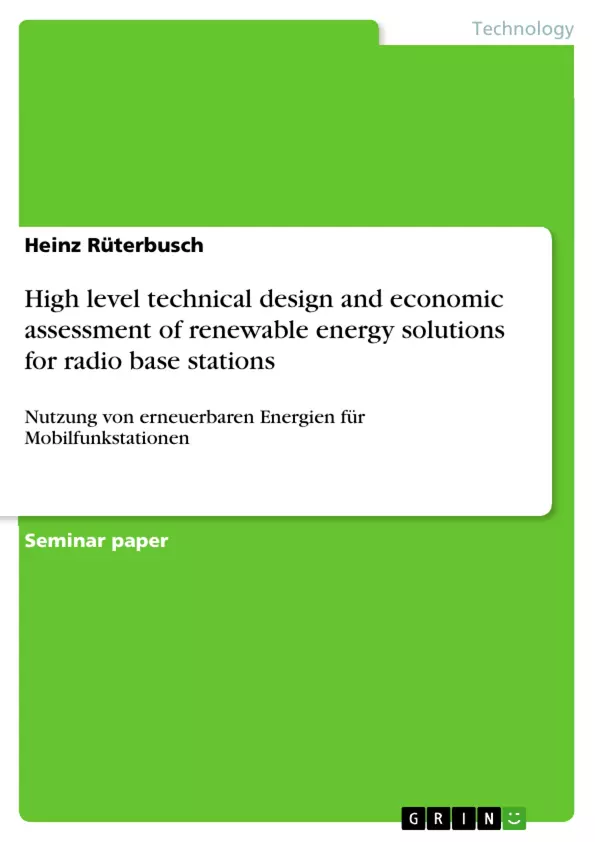This document describes a high level technical design for and the economic assessment of renewable
energy solutions for radio base stations (RBS). It proposes a way forward in the development of
'hybrid' solutions with renewable energy sources (RES) for off-grid RBS sites.
The main purpose of this document is to provide initial practical, technical and economic guidance.
The following sections outline the specific requirements of mobile operators and provide specific
technical guidance for the selection and implementation of the elements of a hybrid system.
This information will enable mobile operators without any detailed technical and commercial
knowledge to develop initial ideas on the design of such a system and provide them with a common
basis for further discussion, evaluation and benchmarking.
References to external documents in the glossary are in square brackets [ ] and cross links to specific
sections of this document are indicated as follows: >> section_name.
Note: this document is part of my final examination in the renewable energy study module at the
University of Kassel. The precise definition of the term paper can be found in >> Issue definition
Inhaltsverzeichnis (Table of Contents)
- Introduction
- About this document
- About the author
- Issue definition
- Scope
- In scope
- Out of scope
- Mobile operators
- Role and motivation
- Technical context
- Technical characteristics
- How to get RES@RBS
- Network perspective: prerequisites (macro view)
- Site perspective: planning steps (micro view)
- Selected technical recommendations
- General
- Technical design
- Solar
- Wind
- Batteries
- Charger, controller
- Diesel generator
- Accessories (cabling)
- High level RES assessment (RAFORS)
- Purpose
- Abstract
- Simplifications / restrictions
- How to work with RAFORS
- General
- Input data
- Output
- Calculation
- Power
- PV
- Battery
- Wind
- Diesel generator
- Economic aspects
- Way forward
- Definitions
- Glossary
- Abbreviations
- Figures
- Tables
- Abbreviations (formulas)
- Appendix
- Example of a 'Site questionnaire to plan RES based radio stations'
- Example of a 3-phase design
- Example of an RES@RBS assessment with RAFORS
- Suppliers (examples)
- Symbols (electrical)
Zielsetzung und Themenschwerpunkte (Objectives and Key Themes)
This document aims to present a high-level technical design and economic assessment of renewable energy solutions for radio base stations (RBS), focusing on the development of 'hybrid' solutions with renewable energy sources (RES) for off-grid RBS sites. It provides initial practical, technical, and economic guidance for mobile operators, enabling them to understand the key considerations involved in designing and implementing such systems.
- Technical Design of Renewable Energy Solutions for Radio Base Stations
- Economic Assessment of Renewable Energy Solutions
- Integration of Different Energy Sources (PV, Wind, Batteries, Diesel)
- Requirements and Considerations for Mobile Operators
- Planning and Implementation of Hybrid Systems
Zusammenfassung der Kapitel (Chapter Summaries)
- Introduction: Provides an overview of the document's purpose and scope, introducing the concept of renewable energy solutions for radio base stations. It defines the key objectives and outlines the document's structure.
- Mobile Operators: Discusses the role and motivation of mobile operators in implementing renewable energy solutions. This section covers the technical context and technical characteristics of RBSs.
- How to get RES@RBS: Explores the process of implementing renewable energy solutions at RBS sites, considering both network-level prerequisites (macro view) and site-specific planning steps (micro view).
- Selected technical recommendations: Provides detailed technical guidance on designing and implementing various components of a hybrid system, including solar, wind, batteries, chargers, controllers, and diesel generators. This section offers valuable insights into specific technical considerations.
- High level RES assessment (RAFORS): Introduces RAFORS, an EXCEL-based tool for assessing the net present costs of renewable energy solutions for RBS sites. This section explains the tool's purpose, functionality, and limitations. It also provides insights into the calculation process and economic aspects of the system.
Schlüsselwörter (Keywords)
This document focuses on renewable energy solutions for off-grid radio base stations, emphasizing the integration of different renewable energy sources like solar, wind, and batteries. It also covers the technical design, economic assessment, and implementation considerations for mobile operators. Key concepts include hybrid energy systems, net present cost (NPC) analysis, and RAFORS, an EXCEL-based tool for evaluating the economic feasibility of renewable energy solutions. This research explores practical considerations for implementing renewable energy solutions in the context of mobile telecommunications infrastructure.
- Citation du texte
- Dipl.-Wirt. Ing, Dipl.Kfm. Heinz Rüterbusch (Auteur), 2008, High level technical design and economic assessment of renewable energy solutions for radio base stations, Munich, GRIN Verlag, https://www.grin.com/document/115425



